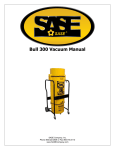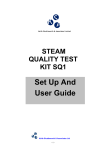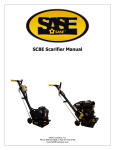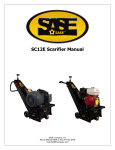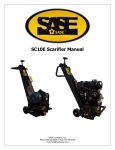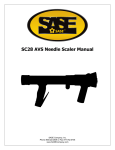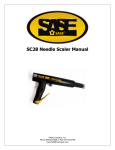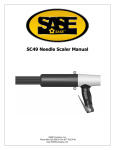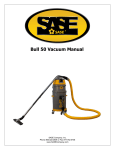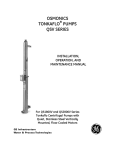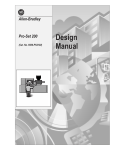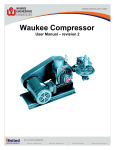Download Sase Bull 300 User`s guide
Transcript
SASE Corporate Office 26423 79th Ave South Kent, WA 98032-7321 1.800.522.2606 (P) 1.877.762.0748 (F) www.SASECompany.com [email protected] Congratulations on your decision to get the Power of SASE behind you! SASE is committed to excellence, excellence in the quality of products we sell and excellence in service and support after the sale. It is important to us that your business continues to succeed and grow, and we know that the right products, service and support can have a great impact on your bottom line. SASE has made great strides in the concrete preparation and polishing industry over the years. With a 40,000 square foot distribution and service facility in Seattle, a 22,000 square foot distribution and service facility in Knoxville, and local sales and technical support representatives throughout the United States, SASE is able to provide unsurpassed service and technical support for the contractor. At SASE we engineer and manufacture our own equipment, which allows us to be in control of the quality of the equipment we sell. SASE offers a complete line of concrete preparation and polishing equipment, our newest introduction being our new line of PDG planetary diamond grinders, which is setting a new standard for the concrete grinding and polishing industry. SASE is also the leader in diamond tooling technology. We look forward to a long and prosperous partnership with you! Thank you again for choosing SASE. You won’t regret having the Power of SASE behind your company! Sincerely, SASE Company, Inc. Jim Weder President S A S E I N D U S T R I A L V A C U U M S WARRANTY SASE Company, Inc. warrants this equipment to operate within the limits of our specification when properly used, properly operated, and properly maintained. Various subsystems are warranted as follows: All metal work excluding paint: 6 years Limited to failure of structural due to poor workmanship. Vacuum Producer: 6 months Limited to premature failure due to poor workmanship by manufacturer. Filters: 2 years (4000 hours) Limited to premature failure due to poor workmanship. Any part proven defective in material and workmanship shall be duplicated without charge F.O.B. your jobsite. This warranty excludes normal wear and tear of parts or equipment, and especially excludes degradation from normal abrasion of corrosion. Please note! The vacuum producer requires unrestricted air flow! Running the SASE Bull 300 “deadheaded” for more than a few minutes will overheat the vacuum producer and void the warranty. This warranty shall be void if the equipment has been altered or if any attempt to repair this equipment has been made by persons, institutions or firms not authorized by SASE Company, Inc. to make repairs. SASE Company, Inc. will not be responsible for any costs of LABOR to remove or re-install equipment, TOOLS, MATERIALS, INSURANCE, OVERHEAD or any INCIDENTAL, SPECIAL, CONSEQUENTIAL or other expenses which may be incurred by the purchaser in the execution of this warranty. SASE Company, Inc. will NOT assume any responsibility under terms of this warranty in parts or equipment which have not been paid for in full, or where an account is outstanding for 60 days or more. Please call 1-800-522-2606 with any questions! S A S E I N D U S T R I A L 1 V A C U U M S Section Bull 300 Series Health and Safety Recommendations The Infor mation Contained In This Section Can Help Prevent Serious Personal Injur y. PLEASE READ THIS SECTION CAREFULLY BEFORE OPERATING OR SERVICING THIS EQUIPMENT. T his section outlines some of the health and safety issues that must be acknowledged when operating or servicing your SASE industrial vacuum cleaning system. It is important that plant operators are made aware of the responsibility incumbent on them to take all necessary precautions to ensure their health and safety, and that plant authorities implement the procedures necessary toward this end. We strongly advise that you, the customer, add to, and tailor, these safety recommendations to suit your own particular working and operating environment. Explosive Dust Please contact us if your process changes so we may help evaluate your risk. The operators of this equipment must always be aware of the physical and chemical properties of the dust particles being collected. A surprising number of dusts are flammable or prone to explosion when mixed with air as we find with a filter receiver application. Materials or processes presenting such hazards MUST be identified by the customer. S A S E I N D U S T R I A L V A C U U M S The customer must also be alert to any changes in the dust material or process. If a new process is introduced after the installation of the vacuum system which changes the composition, quantity, or most especially the chemical type of material being introduced into the vacuum system, this may greatly increase the chance of explosion and fire. If your process is to be changed, or if you have any concerns, we suggest you contact us to see how we can assist you to ensure that the operation of your SASE industrial vacuum cleaning system is as safe as possible. Isolate Electrical Before Maintenance Company specific lockout and safety procedures should be inserted in this section. DO NOT ATTEMPT ANY MAINTENANCE WORK UNTIL ALL ELECTRICAL GEAR HAS BEEN ISOLATED. Isolate all electrical before removing any guards, covers or accessories before beginning any maintenance or repair work. Always lock out the main system blower disconnect before opening any inspection door on any separator or filter receiver. Before re-connecting the electrical supply, ensure that all guards, covers and accessories are correctly replaced. Implement Measures to Handle Respirable Dust Operators must be fitted with appropriate respirators and must wear protective clothing if handling dust that may be irritating or even toxic. We recommend that the MSDS’s for each of the dusts to be handled by the vacuum system be included in this manual, and that specific measures to handle problem materials be clearly identified in those sections of this manual where the operator is exposed to these dusts; i.e. filter bag replacement, etc. S A S E I N D U S T R I A L V A C U U M S Use Suitable Electrical Warning Notices Do NOT leave electrical gear live and unattended without a suitable warning notice. Distinctive warning notices must be provided for posting in a conspicuous position to any piece of electrical equipment or machinery on which maintenance is being carried out, and which, for any reason whatsoever, is liable to be left unattended while in a live condition. Use CAUTION When Using the Hoses SASE vacuum systems use blowers that develop very high vacuum conditions which can be dangerous if caution is not observed. DO NOT PUT THE END OF THE HOSE AGAINST YOUR SKIN OR CLOTHES OR THOSE OF OTHERS! Remove the hose from the inlet valve to dislodge materials that plug the end of tools. S A S E C O M P A N Y , I N C . top of the filter housing by use of tie wraps and the bags must not be loose or out of place. NOTE: A loose or unsecured bag will allow product to pass through the filter separator and will plug the in-line filter. The filter bags should be shaken at least daily, preferably after each use. To shake filter bags, simply shut off the vacuum and shake the filter assembly arm swiftly back and forth. This rapid movement will dislodge particles on the inside of the filter bag surfaces and drop them into the dust can. NOTE: The unit must be OFF in order to shake the filters. If the filters are to be replaced, please replace them ALL at once, or they will be a constant source of frustration. Filter Bag Maintenance The following is a recommended program of preventative maintenance: 1. Check that the filters are seated properly and that they do not appear to be leaking WEEKLY. There should be NO appreciable or visible dust inside the filter housing. 2. Replace ALL the filters if wear points or holes are noticed. 3. If the secondary filter cartridge becomes plugged, check for holes or leakage in the primary filter bags, or upgrade the primary filter material to a more efficient type. 4. Replace the secondary filter cartridge when it becomes dirty. Operators must be outfitted with appropriate respirators and must wear protective clothing if handling dust that may be irritating or toxic. Removing Filter Bags Access the filters by removing the vacuum producer section. To change the filter bags, clip the plastic wrap on each bag tied on the filter shaker assembly inside the tank at the top. Squeeze the spring cuff at the bottom of the bag compressing the snap ring into a “U” shape, and remove from the bag plate hole. S A S E C O M P A N Y , I N C . Vacuum Seals If you experience a “lack of suction”, almost certainly there is a leak in a seal somewhere in the system. The following is a short list of common fail points: 1. Check all gasket seals. If air is leaking in through these seals, dust will normally collect on the inside surface of the housing showing the exact location of the leak. Sometimes, running your hands around the door frame will allow you to locate the leak. Either way, replace the seals as required. 2. Especially check the dust can gaskets. If they are torn or worn, please replace them. 3. DO NOT over-tighten the lifting mechanism. Almost certainly that will cause more problems than it fixes. The dust can flange need only depress the gasket. The seal will form when the system is turned on. Over-tightening the lifting mechanism will only lead to premature wear of the gasket and will cause constant problems. 4. Check the hoses for cracks and leaks. A hose covered in duct tape is a sure indicator that the hoses should be replaced. Product Bulletin LAMB ELECTRIC Model: 121018-00 SPECIAL FEATURES - Suitable for 120v AC operation, 50/60 Hz Speed control capability UL component recognized Provision for grounding Brushless Switched Reluctance design 10 mm shaft and bearing system Flat fan system Fuse protection included on electronics circuit board - Aluminum fan end bracket designed to dampen vibration and improve durability DESCRIPTION - One stage - 120 volts - 9.0" / 229 mm diameter - Dual ball bearings - Tangential discharge - All aluminum die cast housings used in motor construction Please refer to SR Blower Application Notes (listed below) for details on the operation and wiring of our SR speed control motor. DESIGN APPLICATION - Equipment operating in environments requiring separation of working air from motor ventilating air - Designed to handle clean, dry, filtered air only TYPICAL MOTOR PERFORMANCE.* 80 Flow 250 60 200 50 150 40 30 100 20 50 10 0 2.000 1.750 1.500 1.250 1.125 1.000 0.875 0.750 0.625 0.500 0.375 0.250 0.000 0 Orifice Diameter (Inches) 120 2000 1800 Flow 100 1600 1400 80 1200 60 1000 800 40 600 400 20 200 Watts RPM (In) Vac Flow Air (In.H2O) (CFM) Watts 2.000 16.4 1758 20820 21.8 238.4 612 1.750 16.4 1750 20820 28.4 207.0 692 1.500 16.8 1771 21310 37.1 173.0 754 1.250 15.8 1654 22000 44.8 132.4 697 1.125 14.9 1600 22570 47.8 110.7 622 1.000 14.5 1488 22900 50.1 89.6 528 0.875 13.4 1410 23600 54.5 71.7 459 0.750 12.5 1317 24400 62.3 56.2 411 0.625 12.4 1293 25480 67.5 40.5 321 0.500 11.8 1223 26390 69.5 26.3 215 0.375 11.0 1161 26900 69.6 14.9 122 0.250 11.1 1158 27930 70.4 7.0 58 0.000 10.6 1110 28440 70.1 0.0 0 Orifice Amps Watts RPM (mm) Air Flow--L/Sec. D A T A Vac Vacuum--MM H20 M E T R I C Amps (Inches) Air Flow--CFM Vacuum--Inches H2O D A T A Orifice 300 Vac 70 A S T M (At 120 volts, 60Hz, test data is corrected to standard conditions of 29.92 Hg, 68° F.) (In) Vac Flow Air (mm H2O) (L/Sec) Watts 647 48.0 16.4 1754 20820 627 106.0 40.0 16.7 1765 21163 876 86.5 735 30.0 15.3 1624 22314 1180 56.9 656 23.0 13.7 1430 23425 1356 36.0 476 19.0 12.5 1317 24422 1585 26.4 409 16.0 12.4 1294 25437 1709 19.4 325 13.0 11.9 1230 26299 1760 13.1 226 10.0 11.1 1170 26824 1767 7.8 136 6.5 11.0 1158 27879 1787 3.5 61 0.0 10.6 1110 28440 1781 0.0 0 0 0 0.0 6.5 10.0 13.0 16.0 19.0 23.0 Orifice Diameter (mm) 30.0 40.0 48.0 Note: Metric performance data is calculated from the ASTM data above. * Data represents performance of a typical motor sampled from a large production quantity. Individual motor data may vary due to normal manufacturing variances. Test Specs: TBD Minimum Sealed Vacuum: TBD ORIFICE: 7/8" Minimum Vacuum: TBD Maximum Watts: TBD PRODUCT BULLETIN 121018-00 DIMENSIONS All switched reluctance motors are thermally protected using an auto-reset device. (120v) AC Power Input 90v - 135v Nominal Operating Voltage Manufactured under Patent nos. US5789893, TW81993, SG38957, ZA96/2766, US5760519, EP0702448B1, ZA95/7123 under license from Switched Reluctance Drives Ltd. Other US and foreign patents pending. Copyright code 1998. All rights reserved. IMPORTANT NOTES: Pictorial and dimensional data are subject to change without notice. Contact factory for current revision levels. WARNING When using AMETEK/Lamb Electric bypass motors in machines that come in contact with foam, liquid (including water) - of other foreign substances, the machine must be designed and constructed to prevent those substances from reaching the fan system, motor housing and electrical components. Lamb vacuum motors other than hazardous duty models should not be applied in machines that come in contact with dry chemicals or other volatile materials. Failure to observe these precautions could cause flashing (depending on volatility) or electrical shock which could result in property damage and severe bodily injury, including death in extreme cases. All applications incorporating Lamb motors should be submitted to appropriate organizations or agencies for testing specifically related to the safety of your equipment. Switched Reluctance Blower Application Notes Page 1 Lamb Electric Infin-A-Tek (SR) Blower User's Guide The INFIN-A-TEK blower utilizes a switched reluctance (SR) brushless motor, which is commutated electronically. Similar to a brush type series universal motor, the INFIN-A-TEK (SR) blower operates from AC line voltage (90v - 135v nominal voltage). However, the INFIN-ATEK (SR) blower features an integral electronic control module that rectifies the "AC line voltage" to obtain the DC voltage required to power the motor. The INFIN-A-TEK (SR) blower contains an imbedded microprocessor which controls the SR motor. This feature allows for the addition of an electronic "SPEED CONTROL", which allows the user to remotely control the speed of the blower. Speed control is obtained by use of a low voltage signal (provided by the customer) and can be in the form of either an AC, or DC signal (34V and 48V maximum respectively). The signal voltage tells the motor when to turn on, and also at what speed to operate. It is important to note the SR motor requires a minimum of 3.5V to start the motor, and reaches full speed at 12V. Our "SPEED CONTROL" will present a maximum 20 milliamp load to the control signal voltage. Please consult our wiring diagram listed below for specific wiring details. Please review the diagram below carefully. The connection of the wires from the blower must be in accord with this sketch for the unit to operate properly. (120v) AC Power Input 90v - 135v Nominal Operating Voltage Important Notes: 1. Motor "SPEED CONTROL" can be obtained by supplying either AC (34V maximum) or DC (48V maximum) voltage signal to the motor control wires. The input signal should be applied to the Yellow #20 awg and Orange #20 awg control wires as shown in the above diagram. Failure to limit the above AC and DC input voltages could result in controller damage. 2. A minimum of 3.5V input signal is required to start the operation of the blower, and maximum speed is reached at 12V. All switched reluctance motors are thermally protected using an auto-reset device. Switched Reluctance Blower Application Notes Continued Page 2 Lamb Electric Infin-A-Tek (SR) Blower User's Guide DIAGRAM A: TYPICAL TANGENTIAL EXHAUST SR BLOWER INSTALLATION NOTE: The customer's vent cover must allow for a minimum of 4.0 square inches of cooling area to provide adequate motor cooling NOTE: Motor mounting must not restrict air inlet ports on motor cover DIAGRAM B: TYPICAL PERIPHERAL EXHAUST SR BLOWER INSTALLATION NOTE: The customer's vent cover must allow for a minimum of 4.0 square inches of cooling area to provide adequate motor cooling NOTE: Motor mounting must not restrict air inlet ports on motor cover Installation Notes / Recommendations: The above diagrams (A & B) provide "typical" installation recommendations for the application of Infin-A-Tek (SR) tangential exhaust and peripheral exhaust blower products. This information illistrates the required separation of "working / vacuum air" and "cooling air" within the above product enclosure. The separation of "working / vacuum air" and "cooling air" is essential to maintaining the extended life of the SR blower motors. Prolonged exposure of the motor's electronics to elevated temperatures, is not recommended. AMETEK/Lamb Electric Division 627 Lake Street Kent, Ohio 44240 (U.S.A) Tel: (330) 673-3451 Fax: (330) 673-8994 Revised: July, 2004 SASE BULL 300 27.00 BLOWER 28.38 SOUND PROOFING FILTER SHAKER SILENCERS SAFETY FILTER HEAVY DUTY FRAME 64.37 36.7 SF PRIMARY FILTER 3" OD 5" SASE COMPANY, INC. KENT, WA 98032 800-522-2606



















